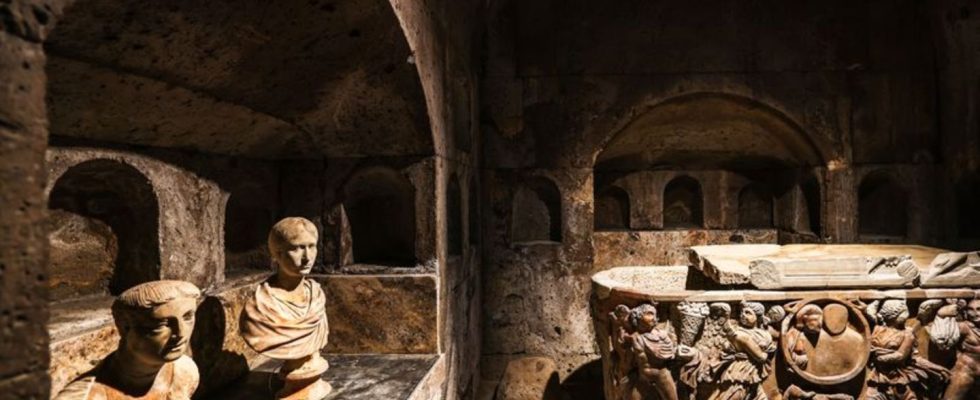Cologne
Descent into the realm of the dead – a grave like Indiana Jones
The Roman grave is almost 2,000 years old. photo
© Oliver Berg/dpa
If you go deeper into Cologne, you can discover a perfectly preserved Roman grave complex. Magical. Mystical. And full of surprises.
A green-painted door opens to reveal a chapel-like room. From there you go down steep stairs into the depths. It gets cooler with each step. The steps on the stone click-clack. Mysterious twilight surrounds the visitor, and then comes a raised trap door. Behind it lies a chamber – Cologne’s Pharaoh’s Tomb.
On the back wall of the chamber there is a sarcophagus decorated with figures, the grave slab of which has been moved. All kinds of things come to mind, depending on your socialization. One person might think of zombies, another might think of Jesus: empty tomb, resurrection and all those things. Three portrait busts stand on the sides. Nose, ears, everything. At first glance, it’s almost too flawless to be real. But the sculptures are originals that are more than 1,800 years old.
The chamber is one of the best-preserved Roman grave complexes north of the Alps. But it is not a museum. “We are an experience space,” emphasizes Professor Heinz Günter Horn, chairman of the Römergrab Weiden support association. “In the museum, the objects are stripped of their context. Here they are exactly where they were in antiquity. This doesn’t exist anywhere else.” It’s an Indiana Jones-esque grave.
Old Roman road
The facility is located in the middle of one of Cologne’s main arterial roads, Aachener Straße – and that is no coincidence: this road was built by the Romans themselves. In its day it was called Via Belgica because it leads to Belgium and on to the French Channel coast. There were gravestones on both sides of the street.
In Roman times, the dead had to be buried outside the city, but as today, the rich and famous wanted to show who they were even in death. That’s why they built as magnificent tombs as possible right on the street. The Roman grave in today’s Weiden district probably also had an above-ground burial temple.
Descent into Roman times
The grave, which was rediscovered in 1843, lived in the shadows for a long time, but in recent years it has been opened to the public by numerous volunteers and can now be visited three days a week for some time. A modern information area introduces the world of the Romans in images and sound, and an extension building with a meeting room and a Roman garden behind it will be opened at the end of May. But all of this takes place above ground – below everything looks like it did in the time of the legionnaires and gladiators.
Archaeologist Horn (83) describes the atmosphere in the burial chamber as “magical, almost mystical,” and he is not exaggerating. When the new development began a few years ago, there were efforts to seal everything with a pane of glass and only allow visitors to look in from the outside – after all, the grave is also a treasure trove full of valuables. But Horn successfully defended himself against this: “I said ‘I bet that people behave down here’. And that’s exactly how it happened.” It is the atmosphere of the place that makes people quiet.
Horn also resisted the temptation to overload the room with information; in fact, there is nothing written down here at all. “People should come in here and be completely absorbed by the atmosphere. They should say ‘Whoa!’ Not more.”
Armchairs and loungers
The biggest surprise in the chamber are two armchairs. Wicker chairs with seat cushions – at least that’s what they look like. In reality they are made of limestone. Their design differs in no way from today’s models – which led to a teacher once falling exhausted onto one of the armchairs in midsummer, apparently assuming that it really couldn’t be antique. There are loungers embedded in the wall, which even invite you to lie down lengthways.
This has to do with the fact that people regularly visited a grave in Roman times and also had meals there, explains Horn. “It is not only a burial chamber, but also a dining room.” During these crypt feasts, people had the feeling of being particularly close to their deceased relatives. The portrait busts represent such family members. In one case, the head of an existing mistress figure was used, which may have been an ornamental figure in the family home. To do this, the hairstyle, which was typical for prostitutes at the time, was reworked. “After all, you didn’t want to put Aunt Emma through that.”
Soft late afternoon light falls through a shaft onto the Carrara marble sarcophagus that a landowner had made for himself and his wife around 300 AD – an expensive imported piece. The family that lived here must have had the status of today’s oligarchs, says Horn. Only the very richest could have afforded something like that. After all: the money was well invested. Today, the realm of the dead on Aachener Straße still bears witness to the world of the living almost 2,000 years ago.
Rönergrab Weiden

